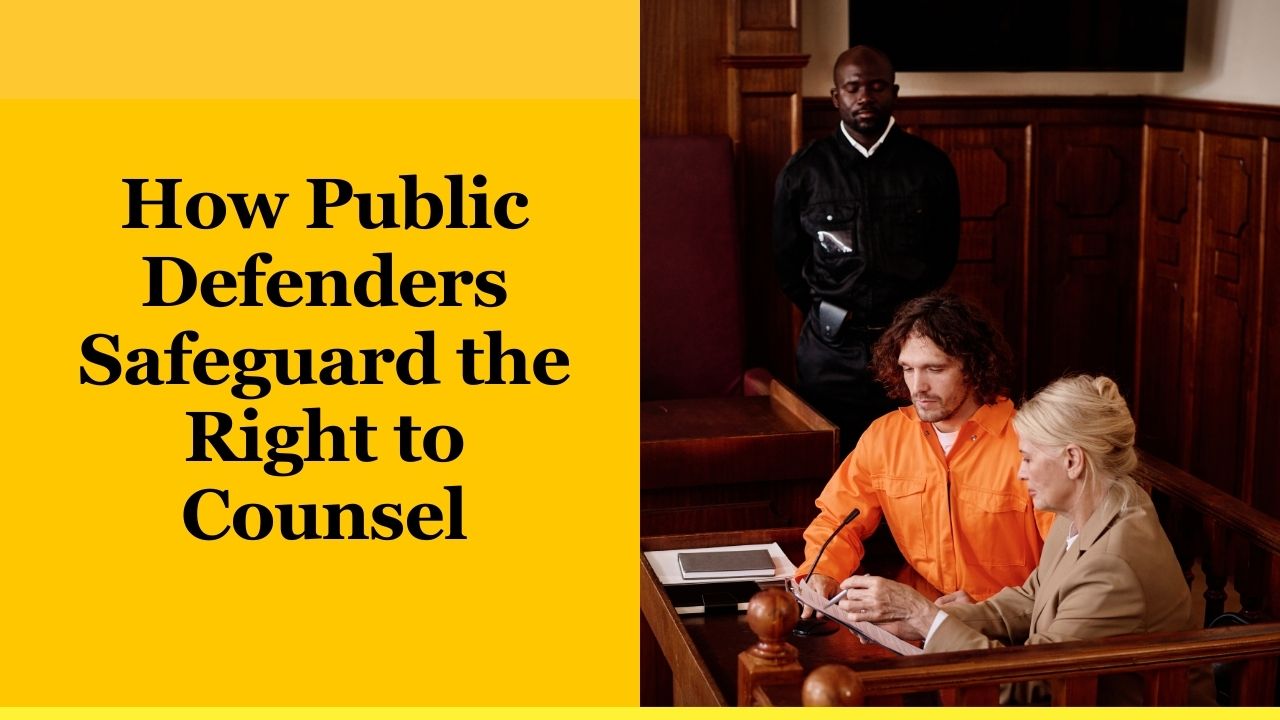Every person accused of a crime in the United States is entitled to effective legal representation—regardless of income.
That constitutional guarantee, rooted in the Sixth Amendment and landmark Supreme Court rulings, is carried out daily by public defenders and court-appointed counsel.
They are the firewall between state power and the individual, ensuring due process, fair trials, and equitable outcomes.
In 2025, their role is more vital—and more strained—than ever, amid rising workloads, digital-evidence explosions, and persistent funding gaps.
Recent data show nearly 90% of federal criminal defendants receive court-appointed lawyers, underscoring how central public defense is to American justice.
The Constitutional Foundation: What the Right to Counsel Really Means
The modern right to counsel in criminal cases was cemented when the Court held that defense lawyers are “necessities, not luxuries” and must be provided to indigent defendants to ensure fair trials. Over time, the Court has clarified when and how that right applies:
- Gideon v. Wainwright (1963): States must provide counsel to indigent defendants in felony cases.
- Argersinger v. Hamlin (1972): No imprisonment may be imposed for a misdemeanor unless the accused had counsel.
- Alabama v. Shelton (2002): Even a suspended sentence that could lead to incarceration triggers the right to counsel.
- Rothgery v. Gillespie County (2008): The right attaches at the start of formal proceedings and extends to critical stages.
- Missouri v. Frye (2012) & Lafler v. Cooper (2012): The right to effective counsel extends to plea negotiations, where most cases are resolved.
Bottom line: Public defenders don’t just show up at trial; they protect the right to counsel from the first appearance through plea bargaining, trial, sentencing, and appeal.
What Public Defenders Actually Do (Beyond the Courtroom)
Public defense is a full-spectrum, client-centered practice. Key responsibilities include:
- Early representation at first appearance: Advising clients on bail, preserving defenses, and preventing rights violations.
- Investigation & discovery review: Interviewing witnesses, reviewing body-cam footage, phone records, social media, and other digital evidence that has dramatically expanded workloads.
- Constitutional motion practice: Challenging unlawful searches, coerced statements, and improper lineups.
- Plea counseling: Applying Frye/Lafler standards to explain offers, risks, and collateral consequences (immigration, housing, employment).
- Trial & sentencing advocacy: Presenting defenses, humanizing clients with mitigation evidence, and advocating for proportionate sentences.
- Reentry and problem-solving court work: Connecting clients to treatment, housing, employment, and diversion programs.
The Scale: Who Relies on Public Defense?
The system is vast and indispensable:
- In the federal system, nearly 90% of defendants are represented by court-appointed counsel; federal defender organizations handle about 60% of publicly financed cases, with the rest covered by qualified private panel attorneys.
- In state courts, a large majority of felony defendants rely on publicly financed counsel, a pattern long documented in national statistics.
These figures reflect the justice system’s reality: public defenders are the primary engine of representation for people facing criminal charges in the U.S.
Why Workloads Matter: From Outdated Caps to Evidence-Based Standards
For decades, the field relied on 1973-era caseload caps (e.g., annual maximums per attorney) that never accounted for modern discovery like body-worn cameras and terabytes of digital data.
A national workload study published in 2023—drawing on 17 state studies and an expert Delphi panel—established evidence-based time standards by case type (e.g., ~286 hours for life-without-parole cases; ~248 for murder; 167 for sex crimes; 57 for mid-felony; 35 for low-felony; ~19–33 for DUI; ~22 for higher-level misdemeanors).
The implication is clear: many offices need substantially more attorney time—and staffing—to deliver constitutionally adequate defense.
Professional groups and state courts are now recalibrating to these standards, with 2024–2025 policy statements and proposals urging reasonable workloads, ethical compliance, and staffing plans that reflect the new evidence.
Some critics debate the study’s methodology and worry about costs, but the broader consensus points to chronic overload that threatens effective assistance.
The 2024–2025 Picture: Shortages, Dismissals, and Reforms
Recent developments illustrate both crisis and progress:
- Oregon’s representation gap: Thousands of people statewide—some in jail for months—have lacked appointed counsel, prompting case dismissals and judicial alarms in 2025.
- San Francisco triage: Overwhelming caseloads led the public defender’s office to pause new intakes one day a week in 2025 to avoid compromising representation.
- Washington’s caseload reset: The state bar backed significantly lower caseload limits, aiming to cut maximums by about two-thirds over several years, though the state high court still must act and funding remains a challenge.
- Pennsylvania funding breakthrough: The first-ever state funding allocation for public defense (though modest) marked a historic shift in 2023 toward state responsibility.
- County-level strain: Local offices report thousands of new felonies and misdemeanors per year with limited staff, reinforcing that workload reform isn’t optional.
Key Facts About Public Defense and the Right to Counsel (2023–2025)
| Topic | Key Takeaway | Why It Matters |
|---|---|---|
| Share of Federal Defendants with Appointed Counsel | ~90% of federal defendants are represented by court-appointed lawyers; federal defender orgs handle ~60% of publicly financed cases. | Public defense is the default, not the exception, in federal criminal cases. |
| State-Court Reliance | A large majority of felony defendants in state courts use publicly financed counsel. | Reinforces that the right to counsel depends on healthy state & county defense systems. |
| Modern Workload Standards | 2023 study sets hours-per-case benchmarks (e.g., 286 LWOP, 248 murder, 57 mid-felony, 35 low-felony, 22 misdemeanor-high). | Evidence-based time helps size staffing, budgets, and ethical caseloads. |
| Policy Momentum | 2024–2025 guidance urges reasonable workloads; states considering new caps and staffing plans. | Links ethics and constitutionality to caseload limits and funding. |
| Active Crises | 2025: Oregon defendants unrepresented; SF pauses new cases weekly; case dismissals mount. | Systemic shortages risk constitutional violations and public safety concerns. |
| Reform Examples | Washington bar votes to cut caseload maximums; Pennsylvania adopts first-ever state funding (2023). | Shows practical pathways—state leadership and funding—to fix the pipeline. |
How Public Defenders Protect Fairness at Every Stage
- Early Appointment & Arraignment: Counsel at first appearance prevents illegal detention, secures reasonable bail, and preserves defenses—critical because the right attaches at formal proceedings and extends to critical stages.
- Investigation & Discovery: Defenders must review voluminous digital discovery—body-cam, phone extractions, social media—before advising on pleas or trial strategy. The time demands are central to modern workload standards.
- Plea Negotiations: Since most cases resolve by plea, the right to effective assistance during plea bargaining (Frye/Lafler) ensures defendants understand offers, consequences, and alternatives—a core protection against coercive outcomes.
- Trial & Sentencing: At trial, defenders test the prosecution’s case; at sentencing, they marshal mitigation, treatment alternatives, and proportionality arguments.
- Post-Conviction & Reentry: Defenders navigate appeals, expungement, and collateral consequences, essential for second chances and community safety.
The Ethics Link: Workload, Effectiveness, and Equity
Effective assistance requires time—for client meetings, investigation, motions, and negotiations. When caseloads exceed ethical limits, the risk isn’t just burnout; it’s ineffective assistance, wrongful convictions, excessive sentences, and erosion of public trust.
Multiple jurisdictions and audits have found attorney workloads outstripping even outdated caps, reinforcing calls for updated staffing and data-driven budgeting.
Funding the Right: What Works
- Stable, statewide funding: Reduces county-by-county disparities and stops over-reliance on fines/fees that distort incentives.
- Evidence-based staffing: Use the hours-per-case benchmarks to align headcount and supervision with constitutional needs.
- Diversion & problem-solving courts: Expanding diversion for non-violent cases can reduce caseload pressure and improve outcomes.
- Technology & training: Tools for discovery review and specialized training (digital forensics, immigration consequences) shorten timelines and improve quality.
- Independent oversight: Structures that protect defender independence from political pressure are crucial to client-first advocacy.
Measuring Success: Outcomes That Matter
- Timely appointment of counsel and early client contact.
- Reduced pretrial detention through smarter bail advocacy.
- Case-appropriate resolutions (dismissals, diversions, fair pleas) that reflect evidence, equities, and community safety.
- Client-reported trust and communication, a hallmark of truly effective assistance.
- Lower recidivism where treatment and tailored sentencing replace unnecessary incarceration.
The Stakes in 2025
When public defense falters—whether from attorney shortages or overloaded dockets—courts dismiss cases, people sit in jail without counsel, and constitutional promises ring hollow. That’s exactly what we’re seeing in parts of the country today.
The solution isn’t theoretical: update workload limits, fund offices to the evidence-based need, and treat the right to counsel as a non-negotiable cost of a free society.
Public defenders are guardians of the Sixth Amendment, turning constitutional text into lived reality. They make courtrooms fairer, plea bargaining more informed, and sentencing more rational. But guarantees are only as strong as the systems that fund and staff them.
The latest workload research, coupled with real-world crises in 2024–2025, demands that policymakers, courts, and communities resource public defense to constitutional standards. Doing so isn’t charity—it is the price of justice.
FAQs
Do public defenders only help at trial?
No. The right to counsel covers critical stages from first appearance to plea bargaining, trial, sentencing, and appeal. Effective assistance during plea negotiations is especially crucial today.
Are caseload limits just about attorney comfort?
No. Reasonable workloads are an ethical and constitutional requirement. Evidence-based hours-per-case standards ensure defenders have time to deliver effective assistance to each client.
Why are some courts dismissing cases?
Where attorney shortages or overloaded offices make timely appointment impossible, judges may dismiss cases to avoid ongoing constitutional violations and unfair proceedings.




